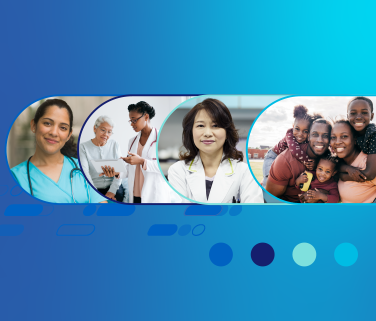National Minority Health Month1 is observed every April to raise awareness about the “disproportionate burden of premature death and illness in people from racial and ethnic minority groups,” according to the National Institutes of Health. This observance is important, but because the health disparities that lead to inequitable outcomes are not easily overcome, work that goes on all year long is needed to make a difference.
A 2022 report from the Federal Office of Minority Health examined the importance of public-private partnerships to “dismantle persistent health disparities.”2 But to have an impact, the authors say, these partnerships must be “collaborative, bidirectional and collectively focused on…equitable health care access,” and, just as important, they must engage with community-based organizations. This approach is a guiding principle for Amgen in working with other organizations to improve health equity.
Amgen works with other organizations across a wide range of initiatives, some of which are discussed below, that address health equity gaps by:
- Empowering patients to take an active role in their care
- Facilitating community participation in developing solutions that are best for them
- Giving healthcare providers the tools, information and support they need to deliver inclusive and cross-culturally informed healthcare
Managing Risk Factors, such as Cholesterol Levels, in At-risk Individuals
The Family Heart Foundation educates and supports people who are genetically susceptible to having elevated cholesterol, particularly elevated LDL or “bad” cholesterol, as well as those with elevated Lipoprotein(a), a particularly sticky type of LDL that further increases the risk of blockages and blood clots.3,4 About 1 in 5 people worldwide have high levels of Lp(a).5
The Family Heart Foundation puts special emphasis on delivering its messages and programming around the importance of lowering LDL to guideline-recommended levels to Black and Hispanic communities. This focus is informed by real-world data collected by the Foundation showing disparities in LDL lowering treatment outcomes. “What we know is if you’re white, you’re more likely to be prescribed recommended care…and if you’re a person who is Black, Asian or female, you’re less likely to achieve your LDL goals,” said Family Heart Foundation president and founder Katherine Wilemon.6,7
EmPOWERED to Serve, an initiative of the American Heart Association (AHA), is accelerating community-driven solutions for reducing disparities in under-resourced communities and communities of color. Through this initiative, community-based organizations provide health lessons to improve health literacy, which is “at the center of health equity,” according to the AHA.
Improving Psoriatic Disease Care in People of Color: When Skin Tone Matters
A program from the IFPA (the International Federation of Psoriasis Associations), called the UPLIFT Innovation Program, encourages development of actionable solutions to address the challenges faced by the psoriatic disease community, including people of color.
Early and accurate diagnosis is important because psoriatic disease is not just an issue of “patchy skin.” Psoriasis is an auto-immune disease that can cause painful inflamed patches on the skin. Psoriatic arthritis, which occurs in up to 1 in 4 people with psoriasis, causes inflammation of joints and the tissues around them.
One part of the challenge for Black, Indigenous and People of Color (BIPOC), according to Sarah Shaw from the Global Healthy Living Foundation (GHLF), a group working directly with patients as part of UPLIFT, is that “in medical schools, psoriasis is shown on white skin and it looks pink to red; when a Black patient comes in with a darker skin tone, it looks more purple or brown.” She goes on to say, “this confuses doctors, and patients are put into this cycle of going round and round to try and get a diagnosis.”
GHLF has two programs that empower everyone living with psoriatic disease to take an active role in their diagnosis and treatment: BIPOC Patient Voices: Living with Psoriasis and Psoriatic Arthritis, which is part of UPLIFT, and An Inside Out Disease. BIPOC Patient Voices: Living with Psoriasis and Psoriatic Arthritis specifically elevates the voices of BIPOC individuals living with the disease to help others hear and learn from the challenges they faced in their often-protracted diagnosis and care journey.
While collaborative relationships between people with psoriatic disease and healthcare providers is essential, IFPA also focuses on additional solutions for health equity. This includes fostering representation among healthcare providers, increasing diversity in their training materials, promoting access to specialists and treatment in rural areas and emphasizing the importance of addressing co-morbidities, which may be common among people with psoriasis.8
Engaging Communities and Individuals at the Point of Healthcare to Overcome Disparities
Black, Hispanic and Indigenous people face the highest burden of asthma in the United States.9 The Asthma and Allergy Foundation of America’s multi-year HEAL Innovation program (Health Equity Advancement and Leadership) is implementing community-level programming in four different cities each year to reduce negative asthma-related health outcomes by partnering with and strengthening local community programs.
When working with an oncologist to decide on the best treatment course for non-small cell lung cancer, “comprehensive biomarker testing is one of the most important steps a patient can take,” says Andrea Ferris, president and CEO of LUNGevity. However, she pointed out that testing rates are particularly low in underserved communities. LUNGevity’s No One Missed campaign is working to deliver information to affected communities to change that.
The Power of Listening: Storytelling Puts a Face on Health Disparities
The Atlantic’s Health Equity Summit, held during National Minority Health Month, featured a conversation between Racquel Racadio, Director of Representation in Clinical Research at Amgen and Sandra Clark, CEO of StoryCorps. Amgen and StoryCorps work together on Every Patient Counts, Every Story Matters: Health Equity Series, which gives people with first-hand experience either facing health disparities or working to change them—and often both—a platform to discuss their experiences.
“My guiding light has always been about people whose voices need to be amplified. People who are unseen and unheard. People who are rarely asked and who are often not believed,” said Clark. Their stories, she says, not only tell us what the issues are, but also are “guides to how we begin to knock away the barriers that exist.”
Racadio says that removing barriers and increasing inclusion is not just a social imperative, but a scientific one. “If we are not collecting full efficacy and safety data when developing medicines, we’re not developing medicines for all patients.” Part of making that happen, she says, is listening to patients, caregivers, and communities to make sure they’re taking the driver’s seat in the way we approach research. “That listening piece of it—that’s the power of StoryCorps,” says Racadio.
Engaging with and listening to communities and patients is the focal point of StoryCorps, but it is a common thread through all of these programs. Whether it’s cardiovascular disease, psoriasis, lung cancer, or asthma, it is vital to learn from those who struggle to access the best possible care. They are also in the best position to explain what they need to feel empowered to take the lead role in their own health, the health of their families and even their communities.
The Office of Minority Health sums it up well, encouraging collaboration that will “let this moment in history be a catalyst for discovery, action, and results that advance partnership for health equity as a common denominator for all communities.”
Together, organizations can achieve more than any one of them can alone.
References
- National Institutes of Health. National Minority Health Month. Accessed May 4, 2023.
- Moore RS, et al. J Health Care Poor Underserved. 2022; 33(4):138-151.
- Centers for Disease Control and Prevention. Lipoprotein (a). Accessed May 4, 2023.
- MedlinePlus. Lipoprotein (a) Blood Test. Accessed May 4, 2023.
- Wilson DP, et al. J Clin Lipidol. 2019; 13(3):374-392.
- Amrock SM, et al. Atherosclerosis. 2017; 267:19-26.
- Zahid S., et al. Circulation. 2022; 146:A9837.
- NCD Alliance and IFPA. Addressing NCDs: Psoriasis and its Co-morbidities. Accessed June 8, 2023.
- Asthma and Allergy Foundation of America. Facts about disparities in asthma. Accessed May 4, 2023.





